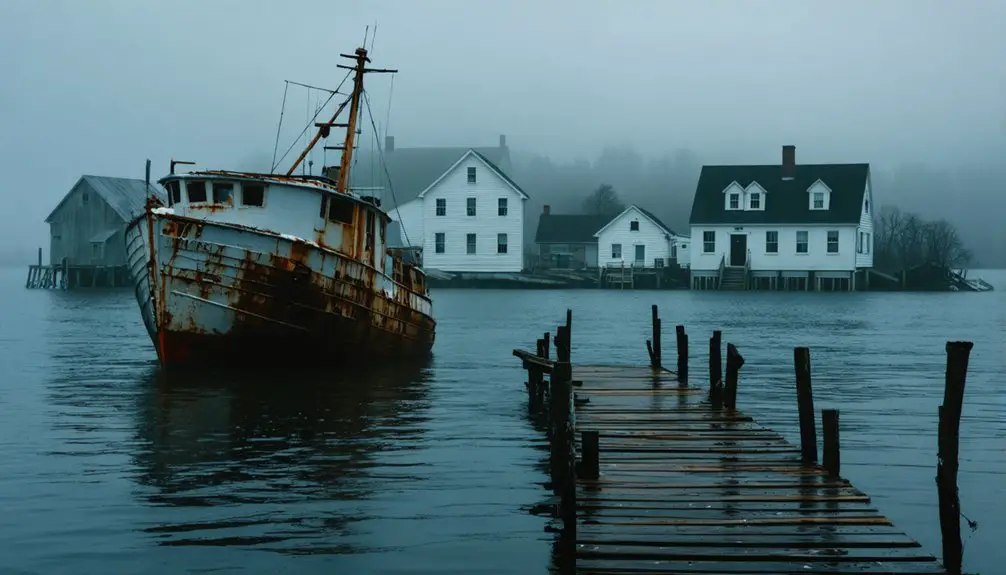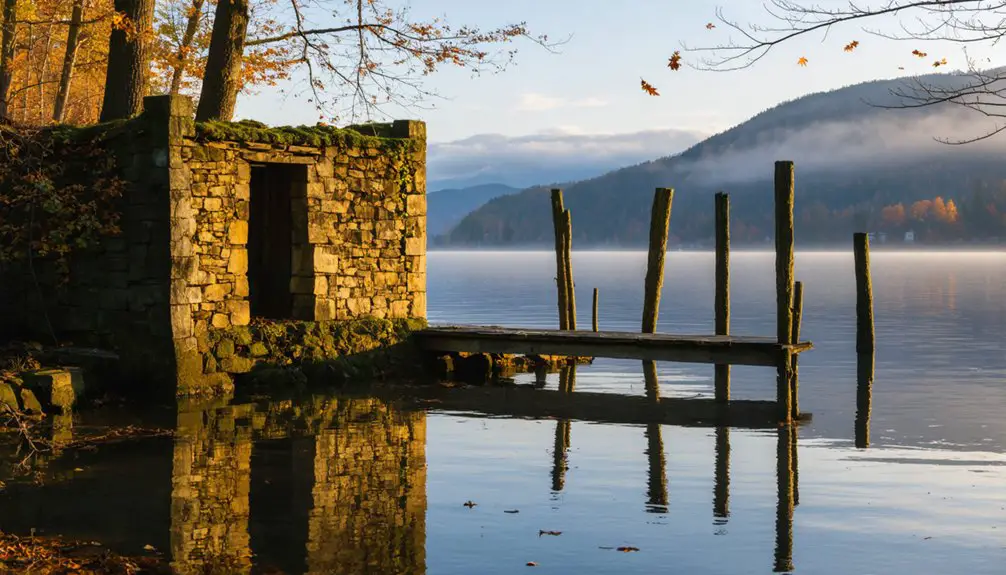You’ll find the haunting ruins of West Castleton along Lake Bomoseen’s shores, where a bustling slate mining town once thrived in the 1850s. Over 800 workers, including Welsh, Irish, and Italian immigrants, labored in 25 quarries during the industry’s peak. The town’s crumbling mill walls, water-filled quarries, and foundation remnants now dot a 3/4-mile historic trail. Local legends of phantom rowboats and mysterious disappearances add an eerie dimension to this industrial ghost town‘s legacy.
Key Takeaways
- Lake, Vermont was home to a thriving slate mining community with 25 quarries and 800 workers during the 1850s-1860s.
- The West Castleton Slate Company operated a 600-acre facility near Lake Bomoseen until its closure in 1929.
- Remnants of the ghost town include crumbling mill walls, water-filled quarries, and foundation ruins from worker housing.
- A 3/4-mile Slate History Trail guides visitors through the abandoned village’s industrial artifacts and historical structures.
- The site is connected to local folklore, including tales of phantom rowboats and the mysterious disappearance of three Irish workers.
The Rise of a Slate Mining Community
When slate mining operations expanded in Lake, Vermont during the early 1850s, the small village quickly transformed into a bustling industrial hub.
You’d find 25 active quarries by 1854, employing over 800 workers who braved dangerous conditions using blasting and manual labor techniques. The arrival of Welsh immigrants revolutionized quarry techniques, bringing specialized skills and tools that dramatically improved operations.
Welsh quarry workers brought vital expertise and innovations that transformed Vermont’s slate industry, turning dangerous manual work into efficient operations.
The community’s growth exploded as infrastructure developed to support the booming industry. The terrain surrounding the quarries featured steep and scenic slopes littered with broken trees and rock fragments.
You could see the changes everywhere – from the West Castleton Railroad transporting slate through forests near Lake Bomoseen to the emergence of sawmills, stores, and worker housing. The slate extracted from these quarries was highly valued for its durability, becoming a sought-after building material throughout the region.
Daily Life in West Castleton’s Heyday
As a slate worker in West Castleton during its peak, you’d start your ten-hour workday at dawn, facing dangerous conditions while quarrying and processing slate for less than $2 per day.
You’d likely live in one of the 43 company houses along Moscow Road or Black Pond Road, sharing the neighborhood with fellow immigrant workers from Ireland, Italy, and Slavic countries. The largely forgotten location remains mostly unknown to modern residents of Rutland County.
The company produced highly sought-after varieties including Vermont Sea Green slate that was processed in their finishing factory. After your shift, you could visit the company store, which served as both a source for essential goods and a community gathering spot where workers socialized.
Slate Workers’ Daily Routines
During West Castleton’s peak slate production years, workers endured grueling 10-hour workdays that started at dawn to maximize daylight hours.
You’d find these laborers, mostly Irish Catholic immigrants, heading to the quarries where they faced the dangers of slate extraction through blasting and manual quarrying. For less than $2 per day, they’d brave harsh weather while shaping and loading slate blocks. The high-quality Paleozoic era slate they extracted became renowned throughout the region.
The company controlled nearly every aspect of workers’ lives. You’d live in their housing, shop at their store, and send your children to their school.
Despite these constraints, workers built strong social networks within their immigrant community to cope with labor struggles. The hazardous conditions, including exposure to slate dust and blasting accidents, made every workday a test of survival in this demanding industry.
Lake Travel After Hours
Once their grueling shifts at the quarries ended, Irish immigrant slate workers would make their way to Lake Bomoseen’s shore for an evening ritual that defined West Castleton’s social life.
You’d find them rowing across the dark waters toward the welcoming lights of a tavern on the opposite shore, where nocturnal adventures awaited with music, ale, and camaraderie.
These nightly crossings weren’t just about leisure – they strengthened community bonds among Irish, Italian, and Slavic workers who’d gather to share stories and relief from their demanding work.
Despite the risks of nighttime navigation, especially during storms that claimed several lives, workers continued this cherished tradition.
The lake became both a pathway and barrier, weaving itself into local folklore with tales of phantom rowboats and creating lasting connections that defined West Castleton’s vibrant immigrant community.
The mysterious disappearance of three local men during a stormy evening crossing became a cautionary tale passed down through generations.
When the slate factories closed, many workers were forced to leave the area, marking the beginning of West Castleton’s transformation into a ghost town.
The Mysterious Vanishing of Three Workers
While gloomy storm clouds gathered over Lake Bomoseen one fateful evening, three Irish quarry workers from West Castleton made the ill-fated decision to cross the lake by rowboat.
Despite warnings from town elders, they set off toward the tavern on the opposite shore, their laughter echoing across the darkening waters. Their mysterious disappearance would become one of Vermont’s most enduring local folklore tales. During this era, the nearby town of Somerset had reached its peak with 321 logging residents. This region would later become known as part of the Bennington Triangle area, where numerous unexplained vanishings have occurred.
When searchers found their empty boat the next morning, you’d discover these haunting details:
- No bodies were ever recovered from the lake or surrounding woods
- Not a single personal item or clue was left behind
- The boat showed no signs of damage or struggle
The case remains unsolved, joining other unexplained vanishings in southwestern Vermont that have earned the region its reputation for supernatural occurrences.
Industrial Heritage Along Lake Bomoseen
The shores of Lake Bomoseen once thrived with industrial might, anchored by the West Castleton Slate Company‘s sprawling 600-acre operation between Lake Bomoseen and Glen Lake.
During the height of slate production in the 1860s, you’d have witnessed one of America’s largest slate mills churning out premium green and purple products, from flooring to billiard tables.
Vermont’s industrial expansion made it second only to Pennsylvania in slate output. You can still explore this legacy today through the quarry holes and vibrant slate rubble piles dotting the western shoreline.
The workforce, mainly Irish immigrants, toiled through ten-hour shifts for less than $2 daily, living in company-controlled housing.
Though the Lake Shore-West Castleton Mill closed in 1929, its impact on the region’s landscape and heritage remains indelibly etched in time. Today, visitors can enjoy year-round recreational activities while exploring these historic industrial remnants.
Haunting Tales From the Shoreline

Dark tales of tragedy and unexplained phenomena haunt the misty shores of Lake Bomoseen, where three Irish slate workers vanished during a fateful nighttime crossing. Their empty boat, discovered drifting the next morning, sparked centuries of phantom sightings and local lore about mysterious disappearances along these waters.
You’ll encounter three distinct elements that make these shoreline hauntings uniquely unsettling:
- The phantom rowboat that appears and vanishes in stormy weather
- Unexplained sounds of splashing oars and distant voices speaking Irish
- Strange lights that drift across the water where the men were last seen
These ghostly tales intertwine with Vermont’s broader supernatural landscape, from Ghost Hollow’s dim passages to Glastenbury Mountain’s legendary disappearances, reminding you that some mysteries of these waters remain forever unsolved.
Archaeological Remnants and Ruins
Standing amid Bomoseen State Park‘s wooded trails, you’ll discover extensive ruins from a once-thriving slate industry town, where crumbling mill walls and water-filled quarries tell stories of 19th-century industrial innovation.
Through archaeological techniques, you can trace the town’s layout from remaining foundations – from workers’ quarters to the grand 1868 slate finishing mill, once among America’s largest.
You’ll spot industrial artifacts like double stacks of slate that anchored quarry pulleys and remnants of the Old Mill and Dam on Hazard Brook.
The site’s most enduring structures, built from stacked slate in the 1880s, include mixed-use buildings that served as stores, offices, and housing for mill supervisors, offering glimpses into the social hierarchy of this immigrant-powered industrial community.
The Slate History Trail Experience
Today, visitors can explore Lake’s industrial heritage along a well-marked 3/4-mile Slate History Trail, which winds through the heart of Lake Bomoseen State Park’s historic district.
You’ll discover the remains of a once-thriving 600-acre slate company village during the hour-long self-guided journey, with trail highlights including water-filled quarries and the historic Barlow House and Museum.
Key visitor experiences along the trail include:
- Examining massive slate rubble piles and double stacks that once anchored quarry pulley systems
- Walking through foundation ruins of worker quarters and the 1868 slate mill
- Exploring the Old Mill and Dam site along Hazard Brook where slate was processed
Trail brochures from the park office provide historical context as you traverse this preserved industrial landscape.
Preserving West Castleton’s Legacy
While the slate quarries of West Castleton fell silent long ago, the abandoned village’s legacy lives on through dedicated preservation efforts at Bomoseen State Park.
You’ll find tangible reminders of the town’s historical significance scattered across 600 acres, from building foundations to towering slate heaps on Cedar Mountain. The park’s cultural preservation initiatives protect these physical remnants while sharing the compelling stories of Irish, Italian, and Slavic immigrants who shaped this industrial community.
Archaeological studies have documented the site’s rich heritage, while interpretive programs bring to life the challenging realities of 19th-century slate mining.
Through carefully maintained trails and educational signage, you’re free to explore this ghost town’s ruins and connect with Vermont’s industrial past, ensuring West Castleton’s story endures for future generations.
Frequently Asked Questions
What Happened to the Families of the Three Men Who Disappeared?
You’ll find the families endured prolonged grief and trauma, often grappling with supernatural disappearance theories. They pursued legal inquiries, cooperated with investigations, and carried complex family legacies through generations.
Are There Any Underwater Ruins Visible When Lake Bomoseen Is Low?
While 80% of West Castleton’s ruins are on land, you’ll mainly see overgrown cellar holes from the western shore. No significant underwater exploration has revealed submerged historical artifacts during low water periods.
What Safety Measures Did Slate Workers Use in the Quarries?
You’d be shocked to learn early slate workers had minimal safety protocols, facing quarry hazards without PPE, proper fall protection, or equipment safeguards. Modern regulations weren’t implemented until the 20th century.
Did Any Other Mysterious Disappearances Occur on Lake Bomoseen?
While you’ll hear mysterious legends and local folklore, Charlotte Moore Buswell’s 1929 death is the only well-documented disappearance on Lake Bomoseen. Other reported vanishings lack solid historical evidence.
Where Did Most Irish Immigrants Settle After West Castleton’s Decline?
You’ll find Irish migration patterns shifted from West Castleton to Burlington’s bustling docks, Winooski’s textile mills, and farming communities like Fairfield, where immigrants built new lives through industrial and agricultural work.
References
- https://www.vermonter.com/ghosts-lake-bomoseen/
- https://obscurevermont.com/ghost-hollow/
- https://www.vermonter.com/ricker-basin-vermont-ghost-town/
- https://vermontcountry.com/2023/10/26/the-haunting-of-glastenbury-mountain/
- https://montpelierbridge.org/2022/10/ghost-towns-of-new-england/
- https://www.youtube.com/watch?v=Yy85eB_ZBh8
- https://www.uvm.edu/~shali/Slate.pdf
- https://vermonthistory.org/vermont-slate-industry
- https://storymaps.arcgis.com/stories/d64e6d62ecd24904bd404415f449e488
- https://theclio.com/entry/92124



